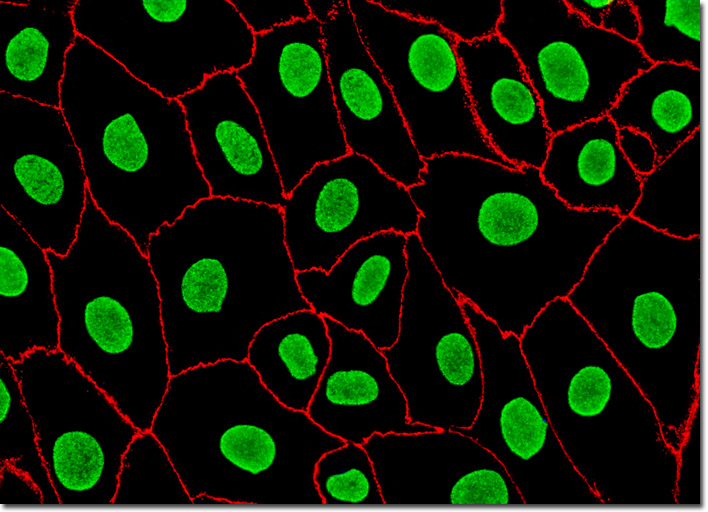Fluorescence Digital Image Gallery
Pig Kidney Epithelial Cells (LLC-PK1)
|
Epithelial tissue serves as a selectively permeable barrier in vivo, separating biological fluids that differ in chemical composition. This important function requires the presence of sealing junctions, termed tight junctions in vertebrates, which effectively bind adjacent cells together into a selective barricade. Tight junctions enable epithelial cells to function as barriers to the diffusion of most proteins, lipids, carbohydrates, and biochemicals, while simultaneously allowing penetration for a specific group of similar species. When visualized in the microscope, tight junctions appear to be composed of an interconnected network of sealing strands that completely encircle the apical portion of each cell in a sheet of epithelia. Intracellular peripheral membrane components known as ZO proteins (derived from the alternate term for a tight junction, zona occludens) serve to anchor junction strands to the actin cytoskeleton. In the digital image presented above, epithelial cell tight junctions and nuclear pore complex proteins were simultaneously imaged in LLC-PK1 cells with a cocktail of mouse anti-NPCP and rabbit anti ZO-3 primary antibodies, followed by goat anti-mouse and anti-rabbit secondary antibodies conjugated to Alexa Fluor 488 and Alexa Fluor 568, respectively. Images were recorded in grayscale with a QImaging Retiga Fast-EXi camera system coupled to an Olympus BX-51 microscope equipped with bandpass emission fluorescence filter optical blocks provided by Omega Optical. During the processing stage, individual image channels were pseudocolored with RGB values corresponding to each of the fluorophore emission spectral profiles. |
© 1995-2025 by Michael W. Davidson and The Florida State University. All Rights Reserved. No images, graphics, software, scripts, or applets may be reproduced or used in any manner without permission from the copyright holders. Use of this website means you agree to all of the Legal Terms and Conditions set forth by the owners.
This website is maintained by our
|
